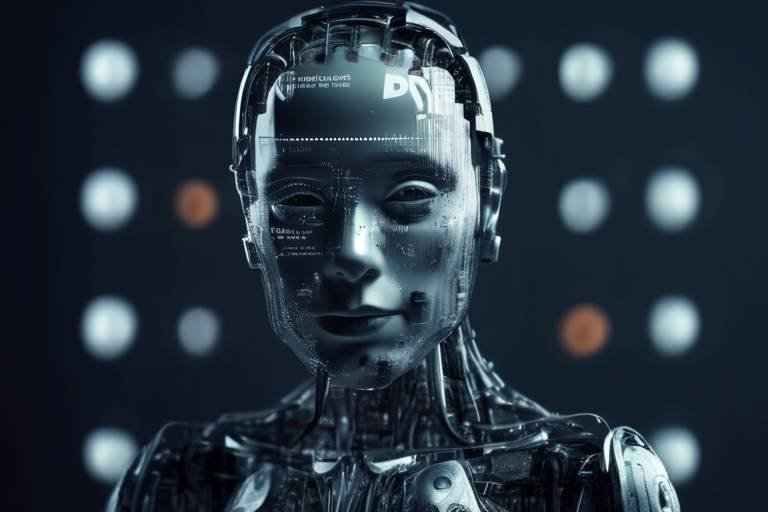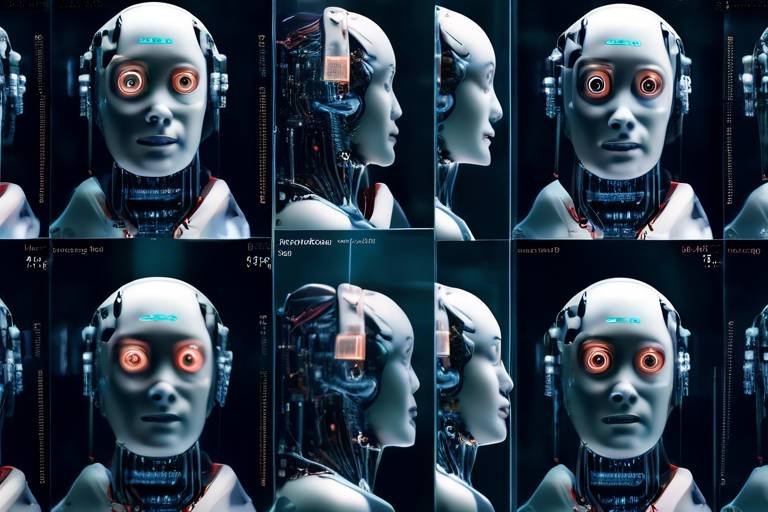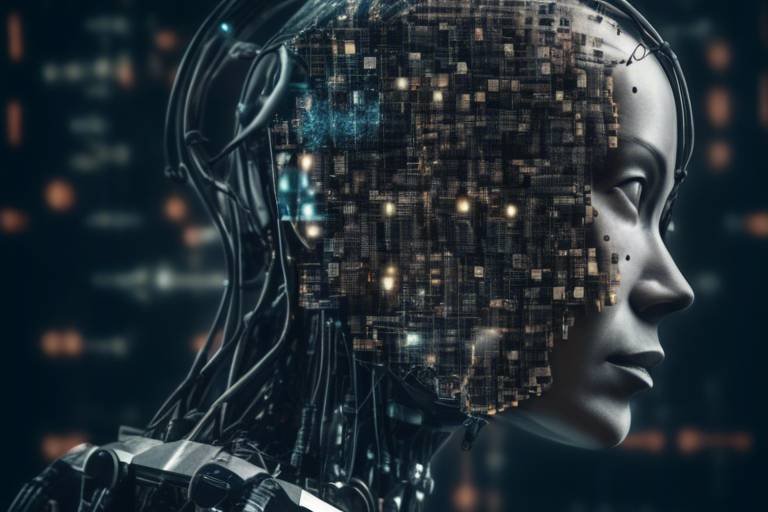AI and Ethics: Crossroads or Collisions?
In today's rapidly evolving technological landscape, the intersection of artificial intelligence (AI) and ethics presents a fascinating yet challenging dilemma. As we integrate AI into our daily lives, we're faced with questions that can no longer be ignored. Are we at a crossroads where we can steer AI towards a more ethical future, or are we heading for a collision course with consequences that could reshape society as we know it? This article delves into the intricate relationship between AI and ethical considerations, exploring the potential conflicts and synergies that arise as technology advances.
The advancements in AI are not just about enhancing efficiency or automating tasks; they also bring forth significant ethical implications. As we witness AI systems making decisions in critical areas like healthcare, finance, and even law enforcement, we must ask ourselves: who is responsible when these systems fail? Do we have adequate frameworks in place to hold AI accountable for its actions? The answers to these questions are crucial as we navigate the complex landscape of AI technology.
Moreover, the ethical frameworks guiding AI development are diverse and multifaceted. From utilitarianism, which advocates for the greatest good for the greatest number, to deontology, which emphasizes duty and rules, and virtue ethics, focusing on moral character, each framework offers a unique lens through which to examine AI's impact on society. Understanding these frameworks is essential for creating AI systems that not only function effectively but also align with our moral values.
As we explore the ethical dimensions of AI, we must also confront the issue of bias. Bias in AI algorithms can lead to significant ethical challenges, affecting fairness and justice in decision-making processes. For instance, if AI systems are trained on biased data, the outcomes can perpetuate existing inequalities, leading to discrimination against certain groups. This raises important questions about the inclusivity of data and the transparency of algorithms, highlighting the need for accountability in AI development.
In conclusion, the relationship between AI and ethics is not merely an academic exercise; it is a pressing concern that demands our attention. As we stand at this crossroads, we must consider how to harness the power of AI responsibly, ensuring that it serves humanity rather than undermining it. The journey ahead will require collaboration, dialogue, and a commitment to ethical principles that prioritize the well-being of all individuals in society.
- What is the main ethical concern with AI? The primary concern revolves around bias in AI algorithms, which can lead to unfair and discriminatory outcomes.
- How can we ensure AI is developed ethically? By implementing transparent algorithms, involving diverse stakeholders, and adhering to established ethical frameworks.
- What role does bias play in AI decision-making? Bias can skew AI results, leading to decisions that may harm underrepresented groups and perpetuate social inequalities.
- Why is public engagement important in AI ethics? Engaging the public fosters awareness and encourages a broader dialogue about the implications of AI, ensuring diverse perspectives are considered.

The Ethical Frameworks Behind AI
Understanding the ethical frameworks that guide artificial intelligence (AI) development is crucial in today’s rapidly evolving technological landscape. As we stand at the crossroads of innovation and morality, it’s essential to explore how different ethical theories influence AI applications. Three primary frameworks come to the forefront: utilitarianism, deontology, and virtue ethics. Each of these frameworks offers a unique lens through which we can assess the implications of AI on society.
Utilitarianism, often summarized by the phrase “the greatest good for the greatest number,” focuses on the outcomes of actions. When applied to AI, this framework prompts developers and policymakers to consider how their technologies can maximize overall happiness and minimize harm. For example, in the realm of healthcare, AI systems that analyze patient data to improve treatment outcomes can be seen as utilitarian, as they aim to enhance the well-being of many individuals. However, this approach raises questions: at what cost do we pursue the greatest good? Are we inadvertently sacrificing the rights of a few for the benefit of the many?
On the other hand, deontology emphasizes the importance of following moral rules or duties. This framework asserts that certain actions are inherently right or wrong, regardless of their consequences. In the context of AI, deontological ethics would advocate for strict adherence to privacy laws and ethical guidelines in data handling. For instance, using AI to analyze sensitive personal information without consent would be considered unethical, even if the results could lead to significant societal benefits. This perspective challenges AI developers to prioritize ethical standards over purely utilitarian outcomes, ensuring that they respect individual rights and dignity.
Lastly, the framework of virtue ethics focuses on the character and intentions of the individuals involved in AI development. It encourages developers to cultivate virtues such as honesty, integrity, and empathy. This approach suggests that ethical AI is not just about following rules or maximizing utility but about fostering a culture of responsibility and care among those who create and implement these technologies. By encouraging developers to embody virtuous traits, we can promote AI systems that are more aligned with human values and societal needs.
As we navigate the complex intersection of AI and ethics, it is essential to recognize that these frameworks are not mutually exclusive. In fact, they can complement each other, providing a more comprehensive understanding of the ethical landscape. By integrating utilitarian principles with deontological responsibilities and a commitment to virtue, we can strive for a balanced approach to AI development that prioritizes both innovation and ethical integrity.
To further illustrate the interplay between these ethical frameworks, consider the following table that summarizes their key characteristics:
| Ethical Framework | Key Focus | Implications for AI |
|---|---|---|
| Utilitarianism | Outcomes and consequences | Maximizing overall benefit; may overlook individual rights |
| Deontology | Moral duties and rules | Adhering to ethical standards; protecting individual rights |
| Virtue Ethics | Character and intentions | Fostering responsible and empathetic AI development |
In conclusion, as AI technology continues to advance, the ethical frameworks guiding its development will play a pivotal role in shaping its impact on society. By understanding and applying these frameworks, we can ensure that AI serves as a force for good, promoting fairness, justice, and human dignity in an increasingly automated world.
- What is the importance of ethics in AI development? Ethics in AI development ensures that technologies are designed and implemented responsibly, considering the potential impacts on society and individuals.
- How can bias in AI be addressed? Addressing bias involves improving data representation, ensuring algorithmic transparency, and fostering a diverse team of developers to create more equitable AI systems.
- What role does public engagement play in AI ethics? Public engagement helps raise awareness about the ethical implications of AI, encouraging diverse perspectives and fostering accountability in AI development.

The Role of Bias in AI
The advent of artificial intelligence (AI) has brought forth a multitude of opportunities and challenges, particularly in the realm of ethics. One of the most pressing issues we face today is the role of bias in AI systems. Bias can creep into AI algorithms in various ways, leading to outcomes that may not only be unfair but can also perpetuate existing societal inequalities. As we increasingly rely on AI for decision-making in critical areas such as hiring, law enforcement, and healthcare, understanding how bias manifests and its implications becomes essential.
Bias in AI can stem from several sources, including the data used to train these algorithms, the design of the algorithms themselves, and the societal influences that shape our understanding of fairness. For instance, if an AI system is trained on historical data that reflects biased societal norms, it may learn and replicate those biases. This creates a feedback loop where the AI continues to reinforce existing prejudices, leading to discriminatory outcomes in real-world applications.
To better understand the nuances of bias in AI, it is vital to explore its sources. Here are some of the key contributors:
- Data Selection: The choice of data used to train AI models can introduce bias. If certain groups are underrepresented in the training data, the AI may not perform well for those demographics.
- Algorithm Design: The way algorithms are structured can inherently favor certain outcomes over others, leading to biased results.
- Societal Influences: Societal norms and values can seep into AI systems, reflecting the biases of the creators and the broader culture.
Data representation is a critical factor that can skew AI results. When training datasets lack diversity, the AI struggles to generalize across different populations. For example, facial recognition systems have been shown to perform poorly on individuals with darker skin tones, primarily because the training data lacked sufficient representation of these groups. This inequity not only affects the technology's effectiveness but also raises serious ethical concerns regarding fairness and justice.
Algorithmic transparency plays a crucial role in addressing bias. If the inner workings of AI algorithms are opaque, it becomes challenging to identify and rectify biases. Making AI algorithms understandable and accessible allows stakeholders to scrutinize their decisions and hold developers accountable. This fosters trust and encourages a more equitable approach to AI deployment.
The consequences of bias in AI systems can be profound and far-reaching. Biased algorithms can lead to discriminatory practices, such as unfair hiring processes or unjust legal outcomes. For instance, a hiring algorithm that favors candidates from specific demographics can perpetuate workplace inequalities. In law enforcement, biased predictive policing algorithms can disproportionately target marginalized communities, exacerbating social tensions and mistrust.
As we navigate this complex landscape, it is crucial to recognize that bias in AI is not merely a technical issue but a moral one. It challenges our understanding of fairness, justice, and accountability in a world increasingly governed by algorithms.
Q: What is AI bias?
A: AI bias refers to systematic and unfair discrimination in AI systems, often resulting from biased training data or flawed algorithm design.
Q: How can we mitigate bias in AI?
A: Mitigating bias involves using diverse and representative training data, ensuring algorithmic transparency, and regularly auditing AI systems for fairness.
Q: Why is algorithmic transparency important?
A: Algorithmic transparency is essential for accountability, allowing stakeholders to understand how decisions are made and to challenge biased outcomes.

Sources of Bias
When we talk about bias in artificial intelligence, it's crucial to understand the various sources that contribute to this pervasive issue. Bias doesn't just appear out of nowhere; it's woven into the very fabric of AI systems, often reflecting the prejudices and inequalities present in our society. One of the primary sources of bias is the data selection process. If the data used to train an AI model is skewed or unrepresentative of the broader population, the outcomes will inevitably be biased. For instance, if an AI system is trained predominantly on data from a specific demographic, it may perform poorly when applied to individuals outside that demographic, leading to unfair treatment.
Another significant source of bias lies in the algorithm design. The algorithms themselves can introduce bias based on how they process data and make decisions. If the underlying assumptions of the algorithm favor certain groups over others, the results will reflect that bias. Additionally, societal influences play a critical role. The biases that exist in our culture can seep into AI systems through the data and the people who design these technologies. It's like a mirror reflecting society's flaws back at us, magnified by the power of machine learning.
In examining these sources, we can categorize them into three main areas:
- Data Selection: The choice of data can heavily influence AI outcomes. If certain groups are underrepresented, the AI will not learn to recognize or respond appropriately to them.
- Algorithm Design: The way algorithms are structured can lead to biased decision-making if they are not carefully crafted to account for diverse scenarios.
- Societal Influences: Existing societal biases can be inadvertently encoded into AI systems through the data and the intentions of the developers.
Moreover, data representation issues can significantly skew AI results. When training data lacks diversity, the AI's ability to generalize and make fair decisions diminishes. For example, facial recognition technologies have shown higher error rates for individuals from minority groups, primarily due to inadequate representation in the training datasets. This inequity can lead to serious consequences, such as wrongful accusations or misdiagnoses in healthcare applications.
Ultimately, addressing these sources of bias is not just a technical challenge; it's an ethical imperative. The future of AI depends on our ability to create systems that are not only intelligent but also fair and just. By acknowledging and actively working to mitigate these biases, we can strive for a technological landscape that benefits everyone, rather than perpetuating existing inequalities.

Data Representation Issues
Data representation issues are a critical concern in the realm of artificial intelligence, as they can significantly skew the results produced by AI systems. When we talk about data representation, we refer to how data is collected, processed, and utilized in training AI algorithms. If the data used to train these systems is not representative of the diverse populations they will ultimately serve, the outcomes can be not only inaccurate but also harmful. Imagine trying to bake a cake but using only half of the ingredients; the result will likely be disappointing. Similarly, AI systems trained on biased datasets can lead to skewed decisions that affect real lives.
One of the most pressing problems is the underrepresentation of certain groups in the training data. For instance, if an AI system is primarily trained on data from one demographic, it may fail to accurately recognize or understand the needs and behaviors of individuals from other demographics. This can lead to a range of issues, from misdiagnosed health conditions in medical AI applications to unfair lending practices in financial algorithms. The implications are profound and can perpetuate existing inequalities in society.
Furthermore, the way data is collected can introduce biases even before it reaches the AI training phase. For example, if data collection methods inadvertently favor certain groups over others—whether due to geographic, socioeconomic, or cultural factors—the resulting dataset will be skewed. This can create a feedback loop where the AI system continues to reinforce these biases, leading to a cycle of discrimination and injustice.
To illustrate this point, consider the following table that highlights the potential impacts of data representation issues across various sectors:
| Sector | Potential Impact of Poor Data Representation |
|---|---|
| Healthcare | Inaccurate treatment recommendations for underrepresented populations. |
| Finance | Discriminatory lending practices based on biased credit scoring algorithms. |
| Law Enforcement | Increased surveillance and profiling of specific communities. |
In conclusion, addressing data representation issues is not just a technical challenge; it is an ethical imperative. Ensuring that AI systems are trained on diverse, comprehensive datasets is essential for fostering fairness and equity in their applications. By prioritizing inclusivity in data representation, we can work towards creating AI technologies that serve all members of society effectively and justly.

Algorithmic Transparency
In the rapidly evolving landscape of artificial intelligence, emerges as a cornerstone for fostering trust and accountability. As AI systems make decisions that can significantly impact lives—ranging from hiring practices to loan approvals—the need for clarity in how these algorithms function becomes paramount. Imagine using a black box that spits out results without any explanation; it’s not just unsettling, it’s downright dangerous. Transparency allows users and stakeholders to understand the mechanics behind AI decisions, making it easier to identify and rectify biases that may otherwise go unnoticed.
At its core, algorithmic transparency involves the disclosure of how algorithms operate, the data they utilize, and the rationale behind their outputs. This means that developers should not only share the algorithms' codes but also provide insights into the data sets used for training and the potential limitations of these systems. By doing so, organizations can mitigate risks associated with biased outcomes and enhance the overall integrity of their AI applications. For instance, if an AI system is found to favor one demographic over another, transparency helps pinpoint whether the issue lies within the data, the algorithm, or both.
Furthermore, algorithmic transparency is not merely a technical requirement; it fosters a culture of responsibility among developers and companies. When stakeholders are aware of how decisions are made, they are more likely to hold organizations accountable for the consequences of those decisions. This accountability is crucial in sectors like healthcare, finance, and criminal justice, where the stakes are incredibly high. For example, in healthcare, an AI that recommends treatments must be transparent about the data it used to make those recommendations, ensuring that patients receive fair and equitable care.
However, achieving transparency is not without its challenges. There are trade-offs between transparency and proprietary technology. Companies may be hesitant to expose their algorithms due to concerns about intellectual property theft or competitive disadvantage. This creates a dilemma: how do we balance the need for transparency with the need for innovation? One potential solution lies in the concept of explainable AI, which focuses on developing systems that can provide human-understandable explanations for their decisions without revealing sensitive underlying code.
To illustrate the importance of algorithmic transparency, consider the following table that outlines key aspects and benefits:
| Aspect | Benefits |
|---|---|
| Data Disclosure | Helps identify biases and improve data quality |
| Decision Rationale | Enhances user trust and understanding |
| Accountability Mechanisms | Promotes ethical use of AI in critical sectors |
| Stakeholder Engagement | Encourages diverse input and collaboration |
In conclusion, algorithmic transparency is not just a buzzword; it’s a fundamental principle that can guide the ethical development and deployment of AI technologies. By embracing transparency, we pave the way for a future where AI serves as a tool for equity and justice, rather than a source of bias and discrimination. As we continue to integrate AI into various aspects of our lives, let’s ensure that the systems we create are not only intelligent but also understandable and accountable.
- What is algorithmic transparency? Algorithmic transparency refers to the clarity and openness regarding how algorithms operate, the data they use, and the decisions they make.
- Why is algorithmic transparency important? It is crucial for building trust, ensuring accountability, and mitigating biases in AI systems.
- What challenges exist in achieving algorithmic transparency? Companies may face trade-offs between protecting intellectual property and providing transparency, making it a complex issue.
- How can we promote algorithmic transparency? By advocating for explainable AI and encouraging organizations to disclose data sources and decision-making processes.

Consequences of Bias
When we think about the consequences of bias in artificial intelligence, it's like opening a Pandora's box filled with unforeseen repercussions that can affect individuals and society at large. Bias in AI isn't just a technical glitch; it's a societal issue that can lead to significant harm. Imagine a world where algorithms dictate important aspects of our lives—like hiring decisions, loan approvals, or even sentencing in criminal cases—based on flawed data. The ramifications can be devastating.
One of the most alarming consequences of biased AI is discrimination. For instance, in the hiring process, AI systems trained on historical data may favor candidates who fit a specific mold, often excluding qualified individuals from underrepresented groups. This not only perpetuates existing inequalities but also stifles diversity and innovation within organizations. The implications are vast, as companies miss out on talented individuals simply because the algorithm was biased.
Moreover, biased AI can lead to social harm in various sectors. Take law enforcement, for example. Algorithms used in predictive policing have been shown to disproportionately target minority communities, leading to increased surveillance and wrongful accusations. This creates a cycle of mistrust between law enforcement and the communities they serve, exacerbating social tensions. The consequences don't just stop there; they ripple through society, affecting public perception and community relations.
Another significant consequence is the erosion of trust in technology. When individuals and communities realize that AI systems are making biased decisions, it undermines their confidence in these technologies. Trust is a cornerstone of any relationship, and when it comes to AI, the stakes are high. If people believe that AI systems are unfair, they may resist adopting beneficial technologies altogether. This can hinder progress and innovation in fields that rely heavily on AI.
To illustrate these points further, consider the following table that summarizes the key consequences of bias in AI:
| Consequence | Description |
|---|---|
| Discrimination | Exclusion of qualified individuals from underrepresented groups in hiring and other processes. |
| Social Harm | Increased surveillance and wrongful accusations in law enforcement, leading to community mistrust. |
| Erosion of Trust | Loss of confidence in AI technologies, hindering their adoption and progress. |
In conclusion, the consequences of bias in AI are far-reaching and multifaceted. They touch upon critical issues of fairness, justice, and societal cohesion. As we continue to integrate AI into our daily lives, it is imperative to address these biases head-on. The future of AI should not only focus on technological advancement but also on ethical considerations that ensure fairness and equity for all.
- What is AI bias? AI bias refers to systematic and unfair discrimination in AI algorithms, often resulting from biased training data.
- How does bias in AI affect society? Bias in AI can lead to discrimination, social harm, and an erosion of trust in technology.
- What can be done to mitigate AI bias? Implementing diverse datasets, ensuring algorithmic transparency, and fostering public engagement can help mitigate bias.

AI in Decision-Making
Artificial Intelligence (AI) is rapidly transforming the landscape of decision-making across various sectors, and it’s hard to ignore its growing presence. Imagine a world where machines can analyze vast amounts of data in the blink of an eye, making decisions that would take humans days or even weeks. Sounds impressive, right? But with great power comes great responsibility. The ethical implications of relying on AI for critical decisions cannot be overstated, as they touch on fundamental issues of fairness, accountability, and transparency.
In sectors like healthcare, finance, and law enforcement, AI systems are increasingly being used to guide decisions that significantly affect people's lives. For instance, AI can help doctors diagnose diseases faster and more accurately, potentially saving lives. However, this raises ethical concerns, particularly regarding patient data privacy. When AI systems analyze sensitive medical information, how can we ensure that this data is protected? Moreover, what happens if an AI system makes a biased medical recommendation? These are questions that demand careful consideration.
In the financial sector, AI is revolutionizing how banks and insurance companies assess risk and make lending decisions. By analyzing patterns in data, AI can predict which applicants are likely to repay loans and which are not. However, this reliance on AI-driven decisions can lead to ethical dilemmas. For example, if an AI system is trained on historical data that reflects societal biases, it may perpetuate discrimination against certain groups. This raises significant concerns about transparency and accountability in AI systems. Are the algorithms making these decisions understandable to the average person? If not, how can we trust them?
To illustrate the potential impact of AI in decision-making, consider the following table that summarizes the pros and cons of AI applications in various sectors:
| Sector | Pros | Cons |
|---|---|---|
| Healthcare |
|
|
| Finance |
|
|
| Law Enforcement |
|
|
As we can see, while AI has the potential to revolutionize decision-making, it also brings a host of ethical challenges that we must address. The implications of biased algorithms or lack of transparency can have far-reaching consequences, not only for individuals but for society as a whole. It is crucial that we engage in ongoing discussions about these ethical considerations, ensuring that AI serves as a tool for good rather than a source of harm.
Q: How can we ensure AI systems are ethical?
A: Ensuring AI systems are ethical involves implementing transparent algorithms, regular audits for bias, and involving diverse stakeholders in the development process.
Q: What are the risks of biased AI in decision-making?
A: Biased AI can lead to unfair treatment of individuals, perpetuating existing inequalities and causing harm in critical areas like healthcare and finance.
Q: Why is transparency important in AI?
A: Transparency is crucial for accountability, allowing users to understand how decisions are made and ensuring that AI systems can be trusted.

Healthcare Applications
In the rapidly evolving world of healthcare, artificial intelligence (AI) is making waves, transforming the way we diagnose, treat, and manage diseases. Imagine having a digital assistant that can analyze vast amounts of medical data in seconds, identifying patterns and anomalies that even the most experienced doctors might miss. This is the promise of AI in healthcare, but it comes with a set of ethical challenges that we must navigate carefully.
One of the key areas where AI shines is in diagnostics. AI algorithms can process medical images, such as X-rays and MRIs, with incredible accuracy. For instance, studies have shown that AI systems can outperform human radiologists in detecting certain conditions like tumors. However, this leads us to a crucial question: What happens to the doctor-patient relationship when machines start to take over diagnostic roles? While AI can enhance precision, it may also create a disconnect between healthcare providers and patients, as patients might feel like they're just a number in a system.
Moreover, the use of AI in healthcare raises significant concerns regarding patient data privacy. With AI systems relying on vast datasets to learn and improve, the risk of sensitive information being misused or breached becomes a pressing issue. It’s essential for healthcare providers to ensure that robust data protection measures are in place. Patients should feel confident that their medical history and personal information are safeguarded. The ethical implications of data usage in AI applications must be transparent and communicated effectively to build trust.
Another ethical dilemma arises when we consider the potential for biased medical recommendations. If the data used to train AI systems is not representative of the diverse population, the outcomes can be skewed. For example, if an AI model is primarily trained on data from one demographic group, it may not perform as well for patients from other backgrounds, leading to disparities in healthcare quality. This is particularly concerning in critical areas such as treatment recommendations and drug prescriptions, where biased algorithms could result in inadequate care for underrepresented groups.
To illustrate the impact of AI in healthcare, let’s take a look at a table summarizing some of the applications of AI along with their associated ethical concerns:
| AI Application | Benefits | Ethical Concerns |
|---|---|---|
| Diagnostic Imaging | Increased accuracy in detecting diseases | Potential job displacement for radiologists |
| Predictive Analytics | Improved patient outcomes through early intervention | Privacy concerns regarding patient data usage |
| Personalized Medicine | Tailored treatments based on individual patient data | Risk of bias if data is not representative |
As we embrace the benefits of AI in healthcare, it’s imperative to keep these ethical considerations at the forefront of discussions. The path forward lies in developing AI systems that not only enhance healthcare delivery but also prioritize patient rights and equitable treatment. Engaging healthcare professionals, ethicists, and the public in conversations about these issues will be vital in shaping a future where AI acts as a partner in healthcare, rather than a replacement.
- What is the role of AI in healthcare? AI is used to improve diagnostics, personalize treatment plans, and analyze patient data to enhance healthcare outcomes.
- How does AI ensure patient data privacy? AI systems must implement strict data protection measures, including encryption and anonymization, to safeguard patient information.
- Can AI replace doctors in the future? While AI can assist in diagnostic processes, it is unlikely to fully replace doctors, as human empathy and judgment are irreplaceable.

Financial Sector Implications
The integration of artificial intelligence (AI) in the financial sector has revolutionized the way businesses operate and make decisions. From automated trading algorithms to personalized banking experiences, AI is reshaping the landscape of finance. However, with these advancements come significant ethical questions that cannot be overlooked. One of the primary concerns is transparency. When AI systems make decisions regarding loans, investments, or insurance policies, how can we ensure that these processes are fair and understandable?
For instance, consider the use of AI in credit scoring. Traditional credit scoring methods have been criticized for their opacity and potential biases. With AI, the complexity increases, as algorithms may consider hundreds of data points to determine an individual's creditworthiness. This raises a crucial question: if a person is denied a loan, how can they understand the reasoning behind that decision? Lack of transparency can lead to feelings of distrust among consumers, who may feel they are at the mercy of a 'black box' system.
Moreover, the implications of biased algorithms in the financial sector are profound. If an AI system is trained on historical data that reflects societal biases, it may inadvertently perpetuate those biases in decision-making. For example, if the training data predominantly includes profiles from a specific demographic, AI might unfairly disadvantage applicants from underrepresented groups. This could lead to discriminatory lending practices, further widening the gap of inequality in access to financial services.
In addition to ethical concerns, there are also accountability issues. When an AI system makes a decision that results in financial loss or harm, who is responsible? Is it the developers of the AI, the financial institution that implemented it, or the regulators who oversee these technologies? Establishing clear lines of accountability is essential to ensure that consumers are protected and that institutions are held to high ethical standards.
To navigate these challenges, the financial sector must prioritize the development of ethical AI frameworks. This includes implementing regulatory measures that promote algorithmic transparency and fairness. Financial institutions should also engage in regular audits of their AI systems to identify and mitigate biases. By doing so, they can foster trust among consumers and ensure that AI serves as a tool for positive change rather than a source of discrimination.
In conclusion, while AI holds great promise for enhancing efficiency and personalization in the financial sector, it also presents significant ethical dilemmas. By focusing on transparency, accountability, and fairness, we can harness the benefits of AI while safeguarding the interests of all stakeholders involved.
- What are the main ethical concerns regarding AI in finance? The primary concerns include transparency, accountability, and the potential for bias in decision-making processes.
- How can financial institutions ensure their AI systems are fair? By implementing regular audits, promoting algorithmic transparency, and engaging diverse stakeholders in discussions about AI ethics.
- What is the role of regulation in AI ethics? Regulation is crucial for establishing guidelines that promote responsible AI use, ensuring consumer protection, and fostering trust in financial systems.

The Future of AI Ethics
As we stand on the precipice of a new era defined by artificial intelligence, the need for robust ethical frameworks becomes increasingly apparent. The rapid evolution of AI technology is not just a technical challenge; it represents a profound ethical dilemma that society must confront. With AI systems being integrated into nearly every aspect of our lives—from healthcare and finance to education and beyond—the question arises: how do we ensure that these technologies are developed and used responsibly?
One of the key considerations for the future of AI ethics is the establishment of adaptive policies that can keep pace with the speed of technological advancement. Traditional regulatory frameworks often lag behind innovation, creating a gap that can lead to misuse or unintended consequences of AI technologies. As such, it is essential to develop regulations that are not only reactive but also proactive, anticipating potential ethical challenges before they arise. This might involve creating flexible guidelines that can evolve alongside AI capabilities, ensuring that ethical considerations remain at the forefront of AI development.
Moreover, public engagement plays a crucial role in shaping the future of AI ethics. It is not enough for policymakers and technologists to dictate the terms of AI's integration into society; the voices of everyday individuals must be included in these discussions. By fostering a dialogue that encompasses a diverse range of perspectives, we can better understand the societal implications of AI and work towards solutions that reflect the values and needs of the community. This engagement can take many forms, including public forums, collaborative workshops, and educational initiatives aimed at raising awareness about AI's ethical challenges.
In addition to public involvement, there is a pressing need for interdisciplinary collaboration among ethicists, technologists, and legal experts. AI ethics cannot be effectively addressed in isolation; it requires a multidisciplinary approach that takes into account the technical, social, and legal dimensions of AI technologies. By working together, these stakeholders can develop comprehensive strategies that address the multifaceted nature of AI ethics. For instance, a partnership between ethicists and AI developers can lead to the creation of algorithms that are not only efficient but also fair and transparent.
To illustrate the importance of proactive AI governance, consider the following table that outlines potential regulatory approaches:
| Regulatory Approach | Description | Potential Benefits |
|---|---|---|
| Adaptive Legislation | Laws that evolve with technology | Ensures relevance and responsiveness |
| Public Consultation | Engaging the community in discussions | Incorporates diverse perspectives |
| Interdisciplinary Collaboration | Partnerships among various fields | Enhances understanding of ethical implications |
As we look ahead, it is clear that the future of AI ethics will not be a straightforward path. It will require ongoing vigilance, adaptability, and a commitment to inclusivity. We must strive to create an ethical landscape where AI serves humanity's best interests, rather than undermining them. This involves not only addressing current challenges but also anticipating future ones, ensuring that we are prepared to tackle the ethical dilemmas that will inevitably arise as AI technologies continue to develop.
- What are the main ethical concerns surrounding AI? Ethical concerns include bias in algorithms, privacy issues, and the potential for job displacement.
- How can we ensure AI is used ethically? By developing adaptive policies, fostering public engagement, and promoting interdisciplinary collaboration.
- Why is public engagement important in AI ethics? It ensures that diverse perspectives are considered and helps to build trust in AI systems.

Regulatory Approaches
As artificial intelligence (AI) continues to permeate various sectors of society, the need for robust becomes increasingly critical. These regulations aim to ensure that AI technologies are developed and deployed responsibly, mitigating potential risks while maximizing their benefits. The challenge lies in crafting regulations that are flexible enough to adapt to the rapidly evolving nature of AI, yet stringent enough to address the ethical concerns that arise.
Currently, several countries are exploring different frameworks for AI regulation. For instance, the European Union has proposed the AI Act, which categorizes AI applications based on risk levels and imposes varying degrees of regulatory requirements. This tiered approach allows for a more nuanced response to the complexities of AI, ensuring that high-risk applications, such as those used in healthcare or law enforcement, are subjected to rigorous oversight.
In contrast, the United States has taken a more decentralized approach, relying on existing laws to govern AI applications. This has led to a patchwork of regulations across states and sectors, which can create confusion and inconsistencies. However, there are ongoing discussions about establishing a more unified framework that could enhance accountability and transparency in AI deployment.
Regulatory approaches can be categorized into three main types:
- Proactive Regulation: This involves setting guidelines and standards before AI technologies are widely adopted, ensuring ethical considerations are integrated from the start.
- Reactive Regulation: This approach addresses issues as they arise, often in response to public outcry or documented harm caused by AI systems.
- Collaborative Regulation: This involves partnerships between governments, industry stakeholders, and civil society to co-create regulations that reflect diverse perspectives and expertise.
Moreover, regulatory bodies must prioritize transparency and accountability in AI systems. This means that organizations developing AI technologies should be required to disclose information about their algorithms, data sources, and decision-making processes. Such transparency not only fosters trust among users but also facilitates independent audits and assessments of AI systems, helping to identify and rectify biases or errors.
Another essential aspect of regulatory approaches is the emphasis on public engagement. Policymakers need to involve a wide range of stakeholders, including ethicists, technologists, and representatives from affected communities, in discussions about AI regulations. This collaborative effort can lead to more comprehensive and inclusive policies that consider the diverse impacts of AI technologies on society.
In summary, the regulatory landscape for AI is still in its infancy, but it is clear that effective regulations are vital for fostering ethical AI development. By adopting proactive, reactive, and collaborative approaches, and prioritizing transparency and public engagement, we can create a framework that not only safeguards against the potential harms of AI but also promotes its responsible use for the greater good.
Q1: Why is regulation necessary for AI?
A: Regulation is essential to ensure that AI technologies are developed and used ethically, minimizing risks such as bias, discrimination, and privacy violations.
Q2: What are the challenges in regulating AI?
A: The main challenges include the rapid pace of technological advancement, the complexity of AI systems, and the need for regulations to be adaptable to various sectors.
Q3: How can the public be involved in AI regulation?
A: Public engagement can occur through consultations, forums, and collaborations with diverse stakeholders, ensuring that regulations reflect a wide range of perspectives.

Public Engagement and Awareness
In our rapidly evolving digital landscape, the intersection of artificial intelligence and ethics is a hot topic that demands our attention. As AI technologies become increasingly embedded in our daily lives, the need for public engagement and awareness has never been more critical. Imagine AI as a double-edged sword; it has the potential to greatly enhance our lives, but it can also lead to unforeseen consequences if left unchecked. This is where informed public discourse comes into play.
Engaging the public in discussions about AI ethics is essential for several reasons. Firstly, it empowers individuals to understand the implications of AI technologies on their lives. Many people may not realize how AI systems affect everything from job opportunities to privacy rights. By fostering awareness, we can encourage a more informed citizenry that can participate meaningfully in conversations about the direction of AI development.
Secondly, public engagement helps to bridge the gap between technologists and the general populace. Often, technical jargon can alienate those who are not familiar with the intricacies of AI. Therefore, it is crucial to present information in an accessible manner. This not only includes simplifying complex concepts but also actively involving diverse voices in discussions. For instance, community forums, workshops, and social media campaigns can serve as platforms for dialogue. Here, individuals can express their concerns, share insights, and contribute to shaping ethical guidelines for AI.
Moreover, involving diverse stakeholders in these conversations is vital. Different demographic groups have unique perspectives on how AI impacts their lives. For instance, marginalized communities may face specific challenges related to bias in AI systems. By ensuring that these voices are heard, we can develop more equitable and just AI applications. It’s akin to crafting a recipe; the more diverse the ingredients, the richer the flavor of the final dish. In this case, the final dish is a more ethical and inclusive approach to AI.
To facilitate public engagement, here are a few strategies that can be employed:
- Education Initiatives: Schools and universities should incorporate AI ethics into their curricula to prepare future generations for the challenges ahead.
- Community Workshops: Local governments and organizations can host workshops that demystify AI and its ethical implications.
- Online Platforms: Social media and dedicated websites can serve as spaces for discussions, allowing people to ask questions and share experiences.
As we move forward, it's crucial to recognize that creating an ethical AI landscape is not solely the responsibility of policymakers or tech companies. It requires a collective effort that includes the public. Just as a garden flourishes when nurtured by a community, the ethical standards governing AI will thrive when everyone participates. This collaborative approach will not only enhance trust in AI systems but also ensure that these technologies serve the greater good.
In conclusion, public engagement and awareness are foundational to fostering an ethical framework for AI. By actively involving individuals from all walks of life, we can create a more informed society that holds AI accountable. As we navigate the complexities of this technological revolution, let’s ensure that our voices are heard and that we shape the future of AI together.
Here are some common questions regarding public engagement and AI ethics:
- Why is public engagement important in AI ethics? Public engagement ensures diverse perspectives are considered, leading to more equitable and just AI systems.
- How can individuals get involved in discussions about AI ethics? Individuals can participate in community workshops, online forums, and social media discussions to share their views and concerns.
- What role do educational institutions play in AI ethics? Educational institutions can teach students about AI ethics, preparing them to navigate and contribute to the AI landscape responsibly.
Frequently Asked Questions
- What are the main ethical frameworks guiding AI development?
The main ethical frameworks include utilitarianism, which focuses on the greatest good for the greatest number; deontology, which emphasizes duty and rules; and virtue ethics, which centers on the character and virtues of the individuals involved in AI development. Understanding these frameworks helps in navigating the complex ethical landscape of AI.
- How does bias enter AI systems?
Bias can creep into AI systems through various channels, such as data selection, where unrepresentative training data skews results, and algorithm design, where the algorithms may inadvertently prioritize certain outcomes over others. Additionally, societal influences can shape the data and assumptions that drive AI, leading to biased outcomes.
- What are the consequences of biased AI?
Biased AI can lead to serious consequences, including discrimination in hiring practices, unfair lending decisions, and inequitable healthcare recommendations. These outcomes not only harm individuals but can also perpetuate systemic inequalities in society.
- Why is algorithmic transparency important?
Algorithmic transparency is crucial because it allows stakeholders to understand how AI systems make decisions. This understanding fosters accountability and helps to identify and mitigate biases, ultimately building trust in AI applications.
- What ethical concerns arise from AI in healthcare?
In healthcare, ethical concerns include patient data privacy and the potential for biased medical recommendations. If AI systems are trained on biased data, they may produce skewed results that can adversely affect patient care.
- How does AI impact decision-making in finance?
AI's role in finance raises questions about transparency and accountability. AI-driven decisions in lending or insurance can lead to unfair practices if the underlying algorithms are not scrutinized for bias or inequity.
- What regulatory approaches are being considered for AI ethics?
Regulatory approaches are evolving, with discussions around creating frameworks that ensure responsible AI use. Current legislation focuses on accountability, transparency, and the ethical implications of AI technologies, aiming to shape a safer future.
- How can the public engage in discussions about AI ethics?
Public engagement is essential for ethical AI development. Involving diverse stakeholders in discussions raises awareness and encourages a broader perspective on the implications of AI, ensuring that multiple voices are heard in shaping future policies.



















